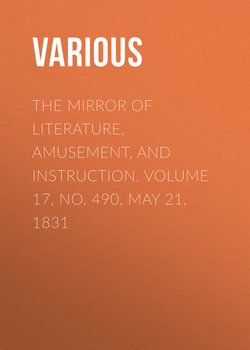Читать книгу The Mirror of Literature, Amusement, and Instruction. Volume 17, No. 490, May 21, 1831 - Various - Страница 1
ОглавлениеOLD HOUSE IN SOUTHWARK.
This crazy, but not unpicturesque building, was taken down in the autumn of last year, in forming an approach to the New London Bridge. It stood on the eastern side of the High-street, and is worthy of record among the pleasing relics of antiquity, which it has ever been the object of The Mirror to rescue from oblivion. Its style of architecture—that of the seventh Henry—is interesting: there is a florid picturesqueness in the carvings on the fronts of the first and second stories, and probably this ornament extended originally to the uppermost stories, which had subsequently been covered with plaster.
We remember the house for the last twenty years, but cannot trace this or any other alteration in its front. The windows, it will be seen, are of different periods, those on the right-hand second and the left-hand third floor being of the oldest date.
Apart from these attractions, and as a specimen of the olden domestic architecture of the metropolis, the annexed Cut bears an historic interest, in its having been the residence of the ill-starred Anne Boleyn, queen of Henry the Eighth. The interior was in palatial style, having been elaborately finished; and in one of the apartments, we learn that the royal arms were very conspicuous.
In early times, Southwark was one of the most celebrated of the metropolitan suburbs; and it is much to be regretted that the liberality of our times has not encouraged the production of its ancient history. Every one at all familiar with London is aware of the antiquity of St. Saviour's Church, the original foundation of which was from the profits of a ferry over the Thames, whence its original name, St. Mary Overy, or "over the ferry." This was some time before the Conquest; but the church was principally rebuilt in the fourteenth century. We have spoken of its ancient fame elsewhere.1 Bankside, its name in spiritual and secular story, is likewise of some note. The early Bishops of Winchester had a palace and park here; remains of the former were laid open by a fire about seventeen years since. Then, who does not remember, in the love of sports and pastimes, the bull and bear-baiting theatres, and the uncouth glory of the Globe theatre, associated with the poet of all time—Shakspeare. Southwark was, therefore, a fitting site for a royal palace for occasional retirement, and its contiguity to the Thames must have enhanced its pleasantness.
Miss Benger, in her agreeable Memoirs of Anne Boleyn, does not mention the Queen's abode in Southwark; but the date of the architecture of the annexed house, and its closer identification with Queen Elizabeth, render the first mentioned circumstance by no means improbable. Previous to the marriage of Anne Boleyn, we learn that Henry passed not a few of his leisure hours "in the delightful society of Anne Boleyn." "Every day they met and spent many hours in riding or walking together." Her family at this time resided at Durham House, on the site of the Adelphi, and Anne frequently made excursions with Henry in the vicinity of London.
Of the antiquity of this district we could quote more proofs. The galleried inn-yards, and among them that at which the Pilgrims sojourned on their road to Canterbury, are among them. In our last volume too, at page 160, we engraved an ancient Vault in Tooley-street, the remains of the "great house, builded of stone, with arched gates, which pertained to the Prior of Lewis, in Sussex, and was his lodging when he came to London." Not far from this was "another great House of Stone and Timber," which, in the thirteenth century, was held of John, "Earl Warren, by the Abbot of St. Augustins, at Canterbury." Stowe says—"It was an ancient piece of worke, and seemeth to be one of the first builded houses on that side of the river, over against the city: it was called the Abbot's Inne of St. Augustine in Southwark."
There was also another "Inne" near this spot, which belonged to the Abbey of Battle, in Sussex, and formed the town residence of its Abbots. This stood on the banks of the Thames, between the Bridge House and Battle Bridge, which was so called, "for that it standeth on the ground, and over a water-course (flowing out of Thames) pertayning to that Abbey, and was therefore both builded and repayred by the Abbots of that house, as being hard adjoyning to the Abbot's lodging." Its situation is known by the landing-place called Battle Stairs. On the opposite side of Tooley-street is a low neighbourhood of meanly-built streets and passages, still denominated the Maze, from the intricacies of a labyrinth in the gardens of the Abbot of Battle's Inn, and which fronted its entrance-gate.
With these few quotations of the ancient importance of Southwark, we can but repeat our regret that no regular history of this district has yet been published. There are three or four gentlemen resident there, whose antiquarian attainments highly qualify them for the task. The public would surely find them patronage.
The Engraving is from an original sketch by an ingenious Correspondent, M.P. of Upton, near Windsor, whom we thank for this specimen of good taste. We are always happy to receive antiquarian illustrations of our Metropolis, and in this instance the zeal of the artist, who resides twenty miles distant, deserves special mention.
1
See Mirror, vol. xiii. p. 227. Gower is buried here, Fletcher and Messenger too; and not long since the bones of Bishop Andrews chapels for the New London Bridge approach.—See also Mirror, vol. xvi. p. 297.
